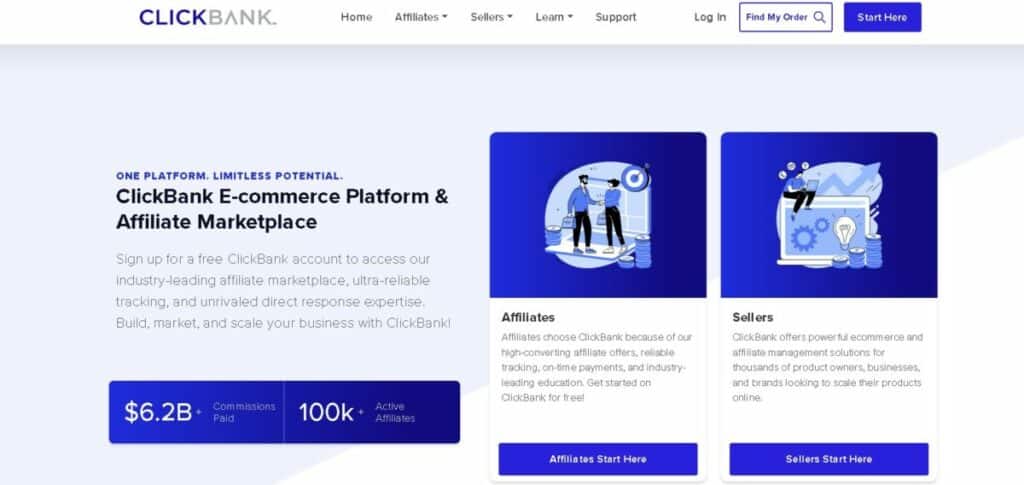So you’ve done your market research and found some possibly profitable products or niches to promote online… now what?
I have received this question from many of my students who have gone through the first module of my “Pay Per Click Ecademy” course on market research.
Affiliate marketing presents a lucrative opportunity for individuals looking to monetize their online presence. By promoting products and services, affiliates earn commissions on the sales they generate.
The key to success lies in finding the right affiliate offers that align with their audience’s interests and needs. Identifying offers with value and relevance can significantly enhance conversion rates and boost earnings. With myriad options available across various sectors, affiliates must invest time in researching and selecting the best programs that suit their niche.
When searching for affiliate offers, one should consider the program’s reputation and its compatibility with its content. Offers with high commission rates and long cookie durations, like those in some high-paying affiliate programs, can be particularly attractive. Additionally, programs that provide robust support, marketing materials, and transparent performance tracking will help affiliates maximize their promotional efforts.
Leveraging networks that aggregate offers, such as Rakuten Advertising or ShareASale, can simplify the search process, making it easier for affiliates to find diverse products and services to promote.
Affiliates must keep in mind the importance of matching their chosen offers with their audience. Promotions that feel authentic and provide genuine recommendations resonate better with potential buyers.
For beginners, starting with well-known platforms like Amazon Associates can be beneficial due to their extensive product range and established trust. Nevertheless, diversifying affiliate offers ensures a wider reach and safeguards against market fluctuations. Incorporating a mix of product types, brands, and commission structures will help build a robust and profitable affiliate marketing portfolio.
Understanding Affiliate Marketing
Affiliate marketing is a performance-based marketing strategy where businesses reward affiliate partners for each customer brought to the company through the affiliate’s own marketing efforts.
Affiliate Programs and Partners
Affiliate programs are arrangements in which an online merchant website pays affiliate websites a commission to send them traffic or sales. These programs are the framework that allows affiliates to promote products and earn income. For example, the Ultimate Guide to Affiliate Marketing in 2024 illustrates how affiliate marketers can leverage these programs to generate revenue.
Finding the Right Program:
- Research extensively: Look for programs in industries that match the affiliate’s interests or expertise.
- Consider the audience: Choose programs with products that directly appeal to the affiliate’s current audience.
Commission Structures and Earnings
The commission structure is a critical component of affiliate marketing. It determines how much money an affiliate can earn from their promotional activities. Payouts can be calculated in various ways, such as a percentage of a sale or a fixed amount per transaction.
Maximizing Earnings:
- Understand the rates: Study the commission percentage or flat rate to estimate potential earnings.
- Sales volume: Increase sales efforts, as earning potential often correlates with the number of sales made, as illustrated where an affiliate earning a 5% commission on 100 sales with an average price of $100 would make $500 a month, per the simplified example.
Choosing Your Niche
Selecting the right niche is a critical starting point for any affiliate marketer. A niche should align with the marketer’s interests and expertise, and also have a sufficient target audience with expressed interest and demand for the products or services being promoted.
Identifying Your Target Audience
Identifying one’s target audience is the foundation of a successful affiliate strategy. This audience’s needs and preferences will guide the affiliate in selecting relevant products or services. It is vital to conduct research and create detailed audience profiles based on demographics, psychographics, and buying behaviors.
For instance, a marketer promoting home fitness equipment should focus on fitness enthusiasts who prefer working at home. Understanding the audience’s challenges and goals enables the creation of targeted and compelling content that resonates with them.
Analyzing Market Demand
Understanding market demand is just as crucial as knowing the target audience. An affiliate marketer should investigate the types of products or services that are in demand within their chosen niche. This exploration can involve keyword research to determine search volume and trends, analysis of competition, and engagement within relevant communities.
For example, a high search volume for “best organic pet foods” signals a strong market demand within the pet care niche. Additionally, existing affiliate programs and the quality of products or services they offer are important to consider to ensure that the marketer’s efforts align with available opportunities and market needs.
Once you’ve found a profitable product or niche to promote, the next step is to source and find companies willing to offer affiliate programs for your products/niche. Here are a few ways to do this:
1. Joining Affiliate Networks

for growth. This involves both the selection of an appropriate network and leveraging that network to build robust affiliate relationships.
Selecting the Right Affiliate Network
When selecting an affiliate network, it’s essential for companies to consider the compatibility between their products and the types of affiliates within the network. For example, Shopify Collabs is ideal for those looking for an app-based marketing tool that helps in creating connections with content creators and influencers. Additionally, the reputation of the network, the quality of customer support, and the payment models offered are critical factors.
Considerations for Selection:
- Compatibility: Match the network’s affiliate types with your product.
- Reputation: Look for networks well-regarded within the industry.
- Support: Ensure there’s adequate customer support.
- Payment: Choose a network with a fair and reliable payment model.
Building a Network of Affiliates
Once the right network has been chosen, the next step is to build a pool of affiliates that can drive growth. Companies can turn their loyal customers into affiliates, as suggested by Influencer Marketing Hub, because they can already be the greatest advocates for the product. Offering competitive commission rates and establishing clear communication protocols are essential in nurturing these relationships.
Strategies for Building Relationships:
- Engage Customers: Convert loyal customers to affiliates.
- Offer Incentives: Competitive commissions to motivate affiliates.
- Clear Communication: Transparent protocols for smooth operations.
International
There are many affiliate networks available, but here are some of the top reputable affiliate networks around today:
- ClickBank – The ClickBank Marketplace has thousands of products, most of which are digital. It is a good place to find information type of products, and they have a good reputation for paying their affiliates.
- Commission Junction – Commission Junction is similar to ClickBank and is quite a reputable company for affiliates.
- ShareASale – ShareASale has more physical products than digital ones. Give them a try if you are searching for physical items to sell.
For Australians
There are two fairly big affiliate networks for Australians, the first one is Commission Monster and the second one is ClixGalore, both are quite big and operate for Australians.
See Related: How to Format Text for SEO Optimization
Identifying High-Converting Offers
When selecting affiliate offers to promote, the ultimate goal is to maximize earnings by focusing on those that yield high conversions and attractive commissions.
What to Look for in an Offer
An affiliate should seek out offers with a solid track record of sales and a reputation for quality. Products that resonate with the target audience and promotions that align with their interests typically result in better conversion rates.
Affiliates must examine the commission structure to ensure profitability since higher commissions can be more lucrative, particularly if the products have a higher price point. It’s also crucial to review the marketing materials provided; comprehensive information, such as banners and email templates, can facilitate more effective campaigns.
For example, an affiliate might prioritize products with an average conversion rate above a specific percentage, such as in high converting affiliate programs with conversion rates.
Assessing Offer Performance
Measuring the performance of affiliate offers is critical. Affiliates should leverage data from their past campaigns to guide decisions. Key performance indicators (KPIs) include the click-through rate (CTR), conversion rate, average order value (AOV), and earnings per click (EPC). If an offer has consistently high EPC, that’s a strong signal of its potential profitability.
Tools and platforms often provide valuable analytics for affiliates to track these metrics. Like A/B testing different affiliate offers, continuous testing and optimization can uncover what resonates with the audience and further improve sales performance. For practical insights, one might analyze case studies from top performers on affiliate platforms like ClickBank’s high-ticket affiliate programs, which often showcase specific strategies and outcomes.
2. Searching Affiliate Directories and Calculating Commission Rates

When exploring affiliate marketing, understanding how to calculate commission rates is critical for gauging potential income. Affiliates must navigate various commission models and estimate earnings based on their promotional efforts.
Understanding Different Commission Models
Different affiliate networks and programs offer various commission models, each impacting an affiliate’s earning potential. Some common models include:
- Cost Per Sale (CPS): The affiliate receives a percentage of the sale price when a purchase is made through their affiliate link.
- Cost Per Action (CPA): The affiliate earns a fixed amount when a specific action, like a sign-up or form submission, is completed.
- Cost Per Click (CPC): The affiliate is paid for each click on their affiliate links, regardless of whether a sale is made.
For example, Fiverr offers a hybrid model, combining a fixed commission with a percentage of revenue. Understanding these models allows an affiliate to select offers that align with their audience and content strategy.
Estimating Potential Earnings
To estimate potential earnings, affiliates should consider the following factors:
- Average conversion rate: How often do clicks on affiliate links lead to a sale?
- Traffic: How many people visit their site or platform?
- Commission rate: What is the percentage or fixed amount they will earn per action?
For instance, if A2 Hosting offers a $55 commission per sale and an affiliate’s website drives 10,000 visitors per month with a conversion rate of 1%, the potential monthly earnings would be 100 sales * $55 = $5,500.
Affiliates need to calculate these potential earnings to set realistic goals and choose the most lucrative offers for promotion.
Some webmasters have created online directories that provide search facilities for affiliate programs. AffiliateScout is one of them. All you need to do is go to AffiliateScout and either browse through the directories, or do a search for your particular keywords to find matching affiliate programs.
See Related: Buy Backlinks Smartly
3. Joining CPA Networks

CPA stands for Cost Per Acquisition or Cost Per Action, a payment model where advertisers pay publishers per-lead basis. Large companies understand that there is a marketing cost to acquire a lead, so what they do is they pay their affiliates a certain amount per qualified lead that the affiliate brings to them.
This has huge potential for you as the affiliate/publisher because you don’t have to sell anything to get paid. All you need to do is to convince targeted people to fill in a form as an expression of interest, and as soon as the form is filled, you get paid for the lead. Below are some great reputable CPA networks:
- AzoogleAds – AzoogleAds is a very popular CPA network amongst internet marketers. However, getting accepted requires you to go through a lot of paperwork, but is very rewarding once you get in.
- Market Leverage – Market Leverage has more financial offers, so is good for anyone wanting to enter this market. They also have many other offers, so they are good to check out. The other cool thing about Market Leverage is that if you are a super affiliate, and make over $1,000 in weekly commissions, you can choose to be paid weekly, instead of monthly like most other affiliate networks.
- NeverBlueAds – NeverBlueAds has a lot of ringtone offers. It’s good for people who are trying to make money from giving away free ringtones.
There are a lot more CPA networks out there but I have not had time to go through and review them all. For your own interest, I have them listed below:
- RocketPocket
- CPA Empire
- Hydra Network
- Pepperjam Network
- CX Digital
- ClickBooth
There is no such thing as a best affiliate/CPA network, it really depends on what you are after, whether it’s support, or the amount of offers available, etc. Each CPA network has its unique competitive advantage, and each has hundreds to thousands of different offers. Go through this list and sign up for a few to see what you can find.
See Related: Steps to SEO Optimize Your Blog Posts
4. Searching on Search Engines

You can go to Google, or any other search engines such as Yahoo, MSN, Bing, etc. and search for your main keyword + affiliate program. For example, if you want to promote golf offers, you can search for golf + “affiliate program” (with the plus sign and quotation marks).
Also, if any affiliate programs related to your keyword are available, the search engines will give you a list to check out.
Evaluating Product Quality
When selecting products to promote as an affiliate, it’s crucial to assess their quality. High-quality products enhance credibility and increase the likelihood of repeat purchases, benefiting both the affiliate and the brand. Affiliates should consider the product’s materials, usability, and customer satisfaction ratings.
Actionable Steps:
- Research the Brand: Investigate the brand’s reputation. Companies with a positive track record are often synonymous with quality. Look for online reviews and check for consistent performance over time.
- Examine Product Details: Carefully review the product descriptions and specifications. If it’s a digital product, consider the content’s value and relevance to the target audience.
- Check Customer Feedback: Look at ratings and reviews from verified purchasers. Pay attention to both the positive and negative feedback to gauge overall satisfaction.
- Request Samples: If possible, try the product or service yourself. Personal experience enables an authentic recommendation.
- Understand the Guarantee: Products backed by a satisfaction guarantee or warranty reflect the company’s confidence in its offering.
Practical Example:
An affiliate looking to promote kitchen gadgets would start by examining several brands. They may contact companies for sample products to conduct live demonstrations, fully experiencing the usability and features of each item. They would monitor customer reviews for any recurring complaints or praises. They’d also value a brand offering a money-back guarantee, as this shows that the brand stands behind its products.
This thorough evaluation ensures that an affiliate promotes only quality products, which in turn increases trust and potentially leads to higher conversion rates.
Leveraging Affiliate Marketplaces
Affiliate marketplaces offer a centralized platform for publishers to find a wide array of products to promote, streamlining the search process and increasing the potential for sales.
Finding Products to Promote
When they begin their hunt for affiliate products, publishers should prioritize finding items that align with their niche and audience interests. Platforms such as Rakuten Advertising provide opportunities to browse through different categories, ensuring a good fit between the product and the audience. It’s critical to select products with a solid track record of sales since this often predicts future performance. By focusing on items with a strong sales history, affiliates improve their chances of earning consistent commissions.
- Research: Spend time exploring various products; look for those with high demand and stellar reviews.
- Comparison: Contrast commission rates across marketplaces to maximize earnings.
- Relevance: Choose products that resonate with one’s brand and audience to ensure authenticity and higher sales.
Using Marketplaces to Increase Reach
Affiliate marketplaces can be instrumental in boosting an affiliate’s reach beyond their existing audience. By taking advantage of a marketplace’s extensive network, they can expose products to a larger audience, which can significantly enhance sales opportunities. For example, the reach of a well-known marketplace like eBay’s affiliate program can help publishers tap into a broader customer base, leveraging the platform’s diversity and reputation for higher conversion rates.
- Visibility: Utilize the marketplace’s tools and SEO practices to increase the visibility of listed products.
- Networking: Engage with other affiliates within the marketplace to discover best practices for promoting products effectively.
Thoughtfully leveraging affiliate marketplaces can streamline a publisher’s search for products, ensure relevance to their audience, and expand their promotional reach. All of these are conducive to driving sales and maximizing their affiliate marketing success.
Building Relationships in the Industry
In the affiliate marketing industry, relationships are the backbone of success. They facilitate access to better offers, insights into performance strategies, and support networks that can help marketers scale up their efforts.
Networking with Other Affiliates
Networking allows affiliates to exchange valuable insights and strategies that can lead to mutual growth. To foster such relationships, affiliates should:
- Attend affiliate marketing conferences and workshops: Engaging with others face-to-face builds trust and opens the door to collaboration.
- Join online forums and groups: Websites like Reddit and specialized affiliate marketing forums are venues where affiliates share tips, experiences, and support.
Practical Example: An affiliate who specializes in tech products could collaborate with another who focuses on software, exchanging audience access and promoting complementary products.
Partnering with Brands
Partnering with brands directly can offer affiliates several advantages such as higher commission rates and exclusive deals.
- Use social media to connect with brands: Directly engaging with companies on platforms like LinkedIn can establish a professional rapport.
- Highlight previous successful campaigns: When reaching out to brands, affiliates should showcase their past successes to demonstrate the potential value they can bring.
Case Study: A blogger in the travel niche used her Twitter network to secure an exclusive partnership with a luggage brand. This partnership resulted in a 20% commission increase due to her demonstrated engagement rates and quality content.
See Related: All About Backlinks or Not?
Tracking and Optimizing for Better Results

To maximize the effectiveness of their affiliate offers, marketers need to track performance rigorously and continually optimize their strategies. One can refine their approach by leveraging precise data and analytics for improved conversions and revenue.
Utilizing Analytics for Improvement
Third-party tools or built-in platform analytics can measure the success of affiliate marketing efforts. Marketers should focus on metrics such as click-through rates (CTR), conversion rates, and the average value per sale. For instance, Google Analytics lets them see which blog posts drive traffic and conversions. They can use this data to understand what content resonates with their audience and tailor their content strategy accordingly.
Testing and Adjusting Strategies
A/B testing is essential for optimizing affiliate marketing. Marketers can compare two versions of their webpage or ads to see which performs better. For example, changing the color or position of affiliate links might affect the click-through rate. This iterative process takes the guesswork out of website optimization, leading to actionable insights and better-aligned affiliate strategies with user behavior.
Employing these tracking and optimization tactics helps marketers improve their pages’ SEO and their ads’ performance, ultimately resulting in more effective affiliate marketing campaigns.
Check out the advertisers’ sales pages and history before signing up for their affiliate programs. Some landing pages and offers are really bad. They do not convert highly or at all. Also, always remember to collect email addresses and a database so you can sell back-end-related offers to them.
This is where most of the profits come from – the back-end sales. If you keep the offers related to each other, e.g., a person buying a product on how to play golf may want to buy some golf shoes and golf clubs, etc. then the customer will thank you for it.
However, if you promote all different products, you will come across as someone trying to make money out of them rather than someone trying to be helpful.
Related Resources
